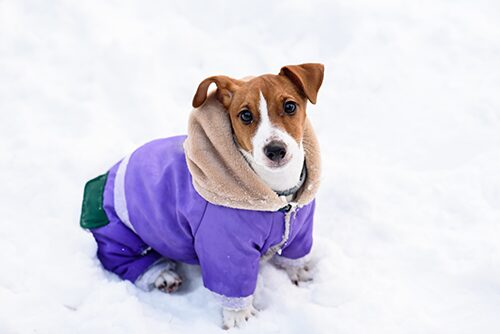Key Takeaways:
- Putting a sweater on your dog in cold weather can help keep them warm and prevent hypothermia.
- It is important to choose the right size and material for the sweater to ensure comfort and proper fit for your dog.
- Not all dogs need a sweater in cold weather, as some breeds have natural insulation and thick coats.
- If your dog shows signs of discomfort or tries to remove the sweater, it may not be suitable for them.
- Regular monitoring of your dog's body temperature and behavior is necessary when using a sweater in cold weather.
Are you a dog lover? Do you ever wonder if your furry friend feels cold during those chilly winter days? If so, you're in the right place! In this article, we will explore the question of whether or not you should put a sweater on your dog in cold weather. Understanding this topic is essential because it can help ensure the comfort and well-being of your beloved pet. Did you know that dogs can be just as susceptible to the cold as humans? By delving into this subject, we will uncover the value of keeping our four-legged companions warm and cozy. So, let's dive in and unravel the mystery behind doggy sweaters in cold weather!
Why Your Dog Needs a Sweater in Cold Weather
When the temperature drops, it's not just us humans who feel the chill - our furry friends can also get cold. That's why it's important to consider getting a sweater for your dog during the winter months. Dogs have fur, but some breeds have shorter or thinner hair that may not provide enough insulation against the cold. A sweater can help keep your dog warm and comfortable when they are outside for walks or playtime.
Protecting Against Hypothermia
Dogs are susceptible to hypothermia, which is a condition where their body temperature drops dangerously low. This can happen if they are exposed to cold temperatures for extended periods without adequate protection. Signs of hypothermia include shivering, lethargy, and pale gums. By providing your dog with a sweater, you can help prevent them from experiencing this potentially dangerous condition.
Keeping Moisture Away
In addition to protecting against low temperatures, sweaters can also help keep moisture away from your dog's fur. When dogs get wet in cold weather, it can be harder for them to stay warm because wet fur loses its insulating properties. A sweater acts as a barrier between your dog's fur and the elements, helping to keep them dry and cozy.
Signs Your Dog is Feeling Cold During Winter
Dogs cannot communicate their discomfort in words like we do, so it's essential to pay attention to their behavior and body language during the winter months. Here are some signs that indicate your dog may be feeling cold:
- Shivering: Just like humans, dogs shiver when they're cold. If you notice your dog trembling or shaking uncontrollably, it could be a sign that they need some extra warmth.
- Seeking Warmth: Dogs naturally seek out warm spots when they're feeling cold. If you find your dog constantly trying to snuggle up next to heaters or curling up in blankets, it's a clear indication that they are feeling the chill.
- Change in Behavior: Cold temperatures can make dogs feel uncomfortable and irritable. If your dog is suddenly more agitated or reluctant to go outside, it could be a sign that they are not comfortable in the cold.
How a Sweater Keeps Your Dog Warm in Chilly Temperatures
A sweater works by providing an extra layer of insulation for your dog. Just like how we wear coats to keep warm, a sweater traps heat close to the body and prevents it from escaping. Here's how a sweater helps keep your dog warm:
Insulation
The materials used in sweaters, such as wool or fleece, have excellent insulating properties. They help retain your dog's body heat and prevent it from dissipating into the cold air. This insulation keeps your dog cozy and comfortable even when the temperature drops.
Covering Vulnerable Areas
Sweaters typically cover the back, chest, and belly of a dog - areas that are more susceptible to getting cold. These parts of the body have less fur or thinner hair, making them more prone to heat loss. By covering these vulnerable areas with a sweater, you provide extra protection against the chilly weather.
Breeds of Dogs That Need Extra Protection in Cold Weather
While all dogs benefit from having a sweater during winter, certain breeds require additional protection due to their characteristics. Here are some breeds that may need extra warmth during colder months:
- Chihuahuas: Chihuahuas have short hair and a small body size, which makes them more susceptible to the cold. They lose body heat quickly and may need extra insulation to stay warm.
- Greyhounds: Greyhounds have thin skin and a lean body, which doesn't provide much natural insulation. They are known for being sensitive to cold temperatures and can benefit from wearing sweaters.
- Miniature Pinschers: Miniature Pinschers have short coats that don't offer much protection against the cold. They are prone to shivering in chilly weather and can benefit from wearing a sweater.
Choosing the Right Size and Material for Your Dog's Sweater
When selecting a sweater for your dog, it's important to choose the right size and material to ensure maximum comfort and effectiveness:
Size Matters
A properly fitting sweater is crucial for your dog's comfort. Too tight, and it can restrict movement and cause discomfort; too loose, and it may not provide adequate warmth. Measure your dog's chest girth, neck circumference, and back length before purchasing a sweater to ensure the perfect fit.
The Right Material
The material of the sweater should be soft, non-irritating, and provide good insulation. Wool is an excellent choice as it is warm, breathable, and naturally moisture-wicking. Alternatively, fleece is another popular option that offers warmth without being too heavy or bulky.
Can Wearing a Sweater Affect Your Dog's Body Temperature?
A properly fitted sweater will not significantly affect your dog's body temperature. Dogs have their natural ways of regulating body temperature through panting or seeking shade when they're too warm. However, it's essential to monitor your dog while they are wearing a sweater to ensure they don't overheat.
Monitoring Comfort
Keep an eye on your dog's behavior and body language while they are wearing a sweater. If you notice excessive panting, restlessness, or signs of distress, it may indicate that they are too hot. In such cases, remove the sweater and allow your dog to cool down.
Proper Dressing for Different Temperatures
It's important to adjust the clothing according to the weather conditions. If the temperature rises or your dog starts exercising vigorously, remove the sweater to prevent overheating. Conversely, if it gets colder or windy, make sure your dog is adequately dressed in their sweater before heading outdoors.
In conclusion, putting a sweater on your dog in cold weather can be a good idea to keep them warm and comfortable. However, it is important to consider your dog's breed, size, and tolerance to cold before making this decision.
At what temperature should a dog wear a sweater?
If there is snow and ice on the ground or if there are consistently cold winds, it is recommended to have a winter jacket for your dog. Breeds that are small or have thin fur, puppies, and older dogs typically require a winter coat when the temperature outside is at or below 32°F (0°C).
Do dogs need a sweater in cold weather?
During the winter, small dogs often need additional insulation because they struggle to keep their body heat. Similarly, medium or large dogs that have experienced muscle loss due to age or illness may also require sweaters to help them retain the heat they generate.
Do dog sweaters actually keep dogs warm?
Dressing a dog with a thick, dense coat in a sweater is usually unnecessary and might even make them too hot. However, for dogs with fine or short hair, a sweater can add an extra layer of insulation to regulate their body temperature and keep them cozy and warm.
How cold is too cold for dogs with a coat?
Exercise caution when the temperature falls below 45 degrees Fahrenheit (approximately 7 degrees Celsius). It may not be safe for small to medium-sized dogs with thin fur to be outside, while larger dogs with thicker fur should be fine.
How do I know if my dog needs a sweater?
By observing their body language, you can determine if your dog requires additional warmth. If your dog is shivering, feels cold when touched, or their teeth are chattering, it is recommended to put a sweater on them. It is possible that your dog may need to wear a sweater indoors as well.
What dog breeds need coats in winter?
However, certain breeds of dogs, such as Chihuahuas and French Bulldogs, need protection from harsh weather conditions. These small dogs, especially those with short hair and miniature sizes, struggle to generate and maintain sufficient body heat to keep themselves warm. This is particularly true for dogs that have a low sitting posture.

















